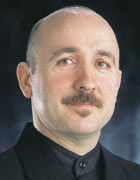Masterclass number 4 - Dystonia and Valsalva - by Roger Webster
18-May-2005Continuing his series, Dr. Roger Webster looks at two serious problems that can cause great problems for players - Dystonia and Valsalva.
 What are they?
What are they?
Many players experience physiological and/or psychological problems during their careers…most manage to ‘muddle through' and survive, others hit a wall and fail to recover. Both are unacceptable as understanding and rectification are the only viable options if we are to continue to follow our chosen pursuit to the max.
Production inhibiting problems are perhaps the most worrying for the performer. A loss of control over when and how they start a note is a powerful psychological obstacle.
‘Yips', a condition that plagues golfers and dart players (sometimes called dartitis)etc and leaves them unable to complete a stroke or release the dart is very similar to the movement disorder such as writer's cramp or in our case musician's production block.
The most common cause of this in brass players is brought about by the Valsalva manoeuvre. (See Antonio Maria Valsalva (1666–1723), Italian anatomist for definition etc)
You can experience what a Valsalva manoeuvre is by trying out the following exercise. Stand up. Curl your fingers, and link both hands together in front of your chest. Take a deep, full breath. Next try to pull your hands apart, as hard as possible, without letting go.
What did you notice while you were pulling? Did you notice how the muscles in your chest and abdomen tightened up? What did you notice about your throat? Did you notice that your throat closed up?
Try the exercise again. Pull really hard and see if you can feel it. Did you notice that, the harder you pulled, the more tightly your throat closed? This closure occurs in the same place that your voice is produced i.e. your larynx.
Now try the same exercise again. This time, start by putting your lips together and pretend you are going to say a p sound. Now pull your hands apart again, as before with all of your strength. What do you notice about your lips? Did you feel your lips pressing tightly together?
Next see what happens when you press the tip of your tongue to the ridge behind your upper front teeth, and pretend you are going to produce a sound through your instrument. Take a deep breath and start pulling. Do you feel the tip of your tongue pressing forcefully? Do these forceful closures feel familiar?
If so, this could be a cause of your particular problem.
Rectification therapy is usually quite straight forward, but unfortunately requires one to one sessions. (due to the specific and personal nature of the ‘problem') thus making it impossible to give a quick fix solution via text.
Most recent reports suggest that the condition causing facial muscle contractions /contortions is not all in the mind, but shows signs of involuntary muscle movements (called co-contractions) similar to task-specific dystonias (movement disorders).
‘Dystonia is a neurological movement disorder characterized by involuntary muscle contractions, which force certain parts of the body into abnormal, sometimes painful, movements or postures. Dystonia can affect any part of the body including the arms and legs, trunk, neck, eyelids, face, or vocal cords.'
These movement disorders are not well-understood but many doctors believe damaged nerves or re-routed neurological pathways may be to blame.
Many famous brass players have had to, or are presently struggling with dystonic or initial production problems.
Scientific studies show that all physical activity, including brass performance is preceded by a neurological tuning of the motor neurons that control the muscles to be used in the particular movement. The tuning makes some neurons more excitable, and others less excitable, to the triggering impulse that actually starts the movement.
In effect, the brain communicates with some neurons, "Pay attention! Get ready to contract your muscles when the next command comes!" To others it says, "Relax. Disregard the next command, because it has no relevance for you." A fraction of a second later, the triggering command comes down the line. The neurons and their muscles either respond or don't respond, depending on their level of excitability.
You can demonstrate this principle yourself, using a colleague. First show them what to do, by using different muscle groups. Make your hand into a fist, or point a finger. Next, tell your colleague to make a fist, as fast as they can, when you say "Now!"
Initially alert them by saying, "Get ready to make a fist." (That is the tuning signal.) Then say "Now!" (which is the triggering signal) as you make a fist yourself. "Not bad," you tell them, "but you are not fast enough. Let's go again."
Repeat this exercise a few times, so that everyone gets into the habit of making a fist as fast as they can. Then, after again instructing them, "Get ready to make a fist," suddenly say, "Point," and point your finger.
Most people reflexively make a fist instead - because that is what their nerves and muscles are neurologically prepared to do.
Although no specific treatment is available, and most doctors have little working knowledge of this type of dystonia, steady and controlled therapy with a combination of musical, neurological and psychological understanding is the most preferred initial path. Most cases will find relief and a greater understanding of their body.
Last resort treatment options have included injections of botulinum toxin, similar to Botox treatments for wrinkles, or oral drugs, which have helped a few people with such conditions.
© Dr R.B.Webster 2005
Also in this series by Roger Webster
» Masterclass number 3: Improving with practice
» Masterclass number 2: Warming up
» Masterclass number 1: Preperation, Practice and Performance















